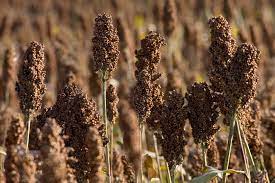No products in the cart.
Discover the Benefits of Common Millet – Your Ultimate Guide
All About Common Millet: A Versatile Grain
Introduction
Welcome to the ultimate guide on common millet! In this article, we’ll delve into everything you need to know about this ancient grain, its health benefits, cooking methods, and much more. Whether you’re a health enthusiast, a foodie exploring new grains, or someone curious about sustainable agriculture, you’ll find this guide insightful.

Table of Contents
| Sr# | Headings |
|---|---|
| 1. | What is Common Millet? |
| 2. | History of Common Millet |
| 3. | Varieties of Common Millet |
| 4. | Nutritional Value and Health Benefits |
| 5. | Cooking with Common Millet |
| 6. | Growing Common Millet: Sustainability |
| 7. | Common Millet in Different Cuisines |
| 8. | Is Common Millet Gluten-Free? |
| 9. | Common Millet vs. Other Grains |
| 10. | Tips for Buying and Storing Common Millet |
| 11. | Common Millet Recipes |
| 12. | Frequently Asked Questions (FAQs) |
What is Common Millet?
Common millet, scientifically known as Panicum miliaceum, is one of the oldest cultivated grains in the world. It’s a small-seeded grain that belongs to the Poaceae family, commonly known as the grass family. Originally domesticated in China around 10,000 years ago, it spread throughout Asia, Europe, and eventually to other continents.
History of Common Millet
Ancient civilizations revered millet for its resilience and nutritional value. It was a staple in diets across Asia and Europe, contributing significantly to the rise of early societies. Today, millet remains an important crop in many parts of the world due to its ability to grow in harsh conditions.
Varieties of Common Millet
There are several varieties of common millet, with the most popular being pearl millet, foxtail millet, and proso millet. Each variety has its own unique characteristics, but all share a mild, slightly nutty flavor.
Nutritional Value and Health Benefits
Nutritional Value:
- Rich in protein, fiber, and essential minerals such as magnesium, phosphorus, and zinc.
- Low in fat and gluten-free, making it a great alternative for those with gluten intolerance.
Health Benefits:
- Heart Health: Helps lower cholesterol levels.
- Digestive Health: Supports healthy digestion due to its high fiber content.
- Weight Management: Supports weight loss due to its low-calorie density and ability to keep you full longer.
Cooking with Common Millet
Cooking common millet is simple and versatile. It can be used in both sweet and savory dishes, from breakfast porridges to salads and pilafs. The grains can be cooked like rice or ground into flour for baking.
Growing Common Millet: Sustainability
Common -millet is a sustainable crop due to its low water and fertilizer requirements. It grows well in poor soil conditions, making it ideal for regions with low rainfall and marginal soils.
Common -Millet in Different Cuisines
Asian Cuisine: Used in traditional dishes such as Japanese millet cakes and Indian millet breads. European Cuisine: Commonly used in porridges and as a base for stuffing.
Is Common- Millet Gluten-Free?
Yes, common- millet is naturally gluten-free, making it a safe choice for people with celiac disease or gluten sensitivity.
Common- Millet vs. Other Grains
Compared to wheat and rice, common -millet offers a higher protein content and a broader range of essential nutrients. It also has a lower glycemic index, making it a better option for blood sugar control.
Tips for Buying and Storing Common -Millet
- Buying: Look for millet in the grains section of your local grocery store or health food store.
- Storing: Store millet in an airtight container in a cool, dry place to maintain freshness.
Common- Millet Recipes
Millet Salad with Roasted Vegetables
Ingredients:
- 1 cup cooked millet
- Assorted roasted vegetables (bell peppers, zucchini, cherry tomatoes)
- Fresh herbs (parsley, basil)
- Olive oil, lemon juice, salt, and pepper to taste
Instructions:
- Cook millet according to package instructions and let cool.
- Toss millet with roasted vegetables and herbs.
- Drizzle with olive oil and lemon juice, season with salt and pepper.
- Serve chilled.
Frequently Asked Questions (FAQs)
What are the health benefits of eating common -millet?
Eating common- millet can help lower cholesterol, support healthy digestion, and aid in weight management.
How do you cook common -millet?
To cook common- millet, use a ratio of 1:2 of millet to water. Bring to a boil, then simmer for about 20 minutes or until all water is absorbed.
Is common -millet suitable for gluten-free diets?
Yes, common -millet is naturally gluten-free and safe for those with gluten intolerance.
What nutrients are in common -millet?
Common -millet is rich in protein, fiber, magnesium, phosphorus, and zinc.
Can you bake with common -millet flour?
Yes, common- millet flour can be used in baking as a gluten-free alternative.
Conclusion
In conclusion, common -millet is a versatile, nutritious, and sustainable grain that offers a wide range of health benefits. Whether you’re looking to diversify your diet, manage your weight, or simply enjoy new flavors, common -millet is an excellent choice. Try incorporating this ancient grain into your meals and experience its goodness firsthand.
Go and turn on towards organic farming to save future and thire save childs:
Elevate Plant Growth with Premium Bone Powder – Buy Now!
Organic Cow Dung Compost: Transform Your Garden Naturally
Premium Humic Acid for Healthy Plants | Enhance Soil & Boost Growth
Boost Plant Growth Naturally with Mustard Cake | Organic Fertilizer
Transform Your Garden with NPK Fertilizer | Boost Growth by 30%
Premium Perlite for Enhanced Gardening | Buy Now
Live Earthworms with Enhance Your Garden (soil health)
1 Neem Khali: Unveiling the Wonders of Nature
1Transform your garden with vermiwash-buy now
1 Premium quality Vermicompost [ केचुआ खाद ]
Follow us:
Tagged Incommon millet

